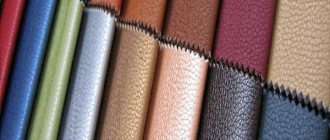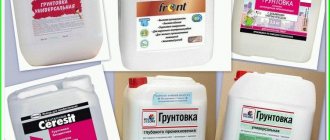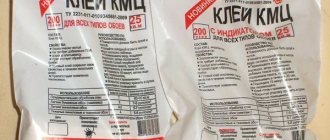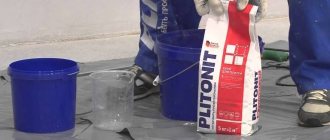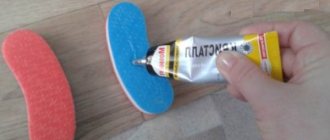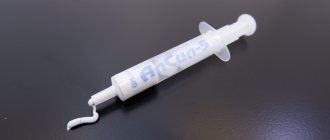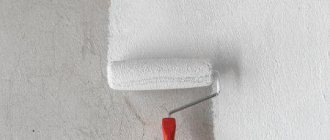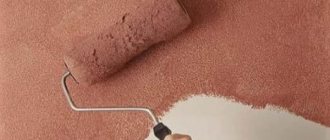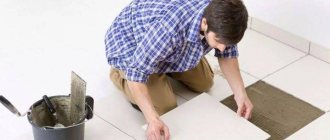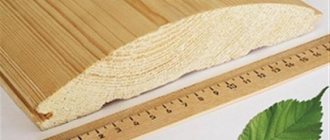Peculiarities
Most often, rubber adhesive is used to join elastic parts. The fact is that after hardening, the structure is really similar to rubber. However, when purchasing such glue, you need to try to ensure that its composition is similar to the parts being joined.
The composition of rubber glue can include not only natural rubber, but also synthetic rubber. Ethyl acetate, chlorine-containing or organic compounds can be used as a solvent. The recipes of all manufacturers are different, so the properties of glue from different brands may differ.
The main feature of rubber-based glue is that it can be used with paper, textile, glass, wood, metal and other materials. It is widely used in the footwear, furniture and automobile industries. However, this glue can also be purchased for household purposes.
What does the product consist of?
Rubber is an excellent elastomer. Previously, it was obtained from dandelion milk or hevea juice. This substance is now being synthesized.
Due to its elasticity and water resistance, rubber serves as an excellent base for glue.
At first, chlorine was used as a solvent, with which the bonded surfaces served for a long time. It had to be abandoned because the smell was very pungent and the composition was highly toxic.
You can purchase the product in the form of a two-component vulcanizing composition. It hardens due to the evaporation of water or vulcanization.
To glue objects with a porous surface, you will have to use wet gluing, removing the solvent. In this case, the items will be very resistant to moisture and microorganisms. At the same time, resistance to solvent and oil does not pass.
Rubber adhesive consists of rubber (click to enlarge)
Types of rubber glue
Rubber glue is classified according to two criteria: the amount of dry residue and the composition of the rubber. At the moment, in accordance with GOST 2179-78 and TU, the amount of dry residue varies between 6-8% and 8-12%. Rubber glue, which contains 6-8% dry residue, is produced under brand A, respectively, quantitatively showing from 8-12% is typical for rubber glue under brand B.
If rubber glue complies with GOST, this guarantees quality and safety. Therefore, before purchasing, you should familiarize yourself with its quality certificate.
Liquid rubber has a broader classification based on the composition of the rubber it contains. Natural rubber adhesives are not suitable for use in some industrial applications, which is why special compounds based on synthetic material have been developed. The fact is that glue made from natural rubber has low resistance to exposure to aggressive environments and high temperatures.
The most common types of rubber glue include the following.
- Adhesive based on natural rubber. The vulcanizing agent in its composition is sulfur. Rubber glue is suitable for joining elements made of paper, leather and fabric.
- Chloroprene rubber adhesive. For vulcanization, divalent metal oxides are added to its composition. It has the most reliable joining abilities, so it is used for gluing parts made of metal, wood, glass and plastic.
- Adhesive containing nitrile butadiene rubber. Sulfur also acts as a vulcanizing agent, but only with the addition of a group of thiurams. This adhesive is water-resistant and is used for materials such as metal, wood, glass and ceramics.
- Adhesive based on silicone rubber. The hardening of such a compound is carried out only under the influence of tetrabutoxylane. Its range of action is limited: it is intended only for joining homogeneous rubber.
- Styrene butadiene rubber adhesive. Due to its weak adhesive ability, it is used only for industrial purposes, in particular for the manufacture of adhesive tape.
Other synthetic rubbers can also act as the basis for rubber glue, but their use is very limited. Therefore, they are not released to retail stores.
What glue to buy
In specialized stores you can purchase an adhesive composition that has passed the necessary tests. Let's look at the main brands you'll find there:
Types of rubber adhesives (click to enlarge)
- "88-SA". This product is made from natural rubber and requires cold gluing. Widely used in everyday life. It can be used to eliminate, for example, gaps between leather products. Perfect for rubber, shoe repair, gluing linoleum and other products;
- "Moment". Can be used for gluing metal, cardboard, rubber, felt, leather, glass, ceramic products. “Moment” rubber is applied to a dried and degreased surface in a thin layer and left for 20 minutes to dry. Then the surfaces are connected for a couple of seconds. The product has a pungent odor, high toxicity and flammability. Therefore, the room where it will be used must be well ventilated. “Universal Moment” has the same properties. This transparent adhesive will be invisible and will bond to any surface. It is one of the best in eliminating various defects.
- "Rubber glue." This is an adhesive based on rubber and gasoline. It is widely used for rubberized fabric and rubber objects.
- "88N". If you need to glue any object to metal, then this product is perfect.
Brands and costs of rubber glue
In order to systematize the information and make it more accessible to ordinary users, all data on popular brands of glue, their application and cost are placed in the table.
| Brand | Characteristics | Material | Approximate price |
| Glue 88 SA | Waterproof, withstands temperatures from -500 to +700o C, does not interact with the surface of products and, accordingly, does not destroy them, protects wooden products from rotting and damage by parasites. | Suitable for products made of wood, metal, rubber, concrete, glass, textiles and leather. | 210 rubles per 1 liter |
| Rubber glue 4508 | Water resistance, elasticity, high connecting ability. | Used for products made of rubber, textiles, leather, paper, cardboard. | 250 rubles for 200g |
| Rubber glue grade A | Quick drying, easy to use, reliable. | Used for leather, textiles, paper, cardboard, rubber. | 198 rubles per 1 l |
| Universal glue “Moment-1” | Quick drying, reliability, versatility, ease of use. | Used for products made of wood, rubber, metal, felt, glass, PVC, plastic, ceramics. | 146 rubles for 125 ml |
Read also: Chameleon welding masks top 10
The table below shows the approximate cost of the product. Prices for similar products may differ depending on the trade markup that is charged by the seller.
How to choose rubber glue?
To choose the right rubber adhesive, you need to clearly understand where it will be used. Before purchasing, you need to answer a number of questions that will allow you to identify the exact requirements for its properties and characteristics.
- Will the product be subject to heating or cooling? Different compounds can withstand different temperature ranges. Therefore, if you plan to use rubber glue in aggressive conditions, you should make sure that it is intended for these purposes.
- Will the product be subject to deformation, shock or vibration? Almost any rubber adhesive has high resistance to mechanical stress. But there are special varieties that have increased tensile strength.
- What size seam should be placed on the product? For thin joints, thinner compounds are chosen, for thick ones, thicker ones.
- What materials need to be glued? In order to choose the right glue, you need to carefully familiarize yourself with the area of its application.
- Will the glue come into contact with food? Many types of glue are extremely toxic. Therefore, for gluing dishes it is necessary to choose special safe compounds.
All properties of the glue can be found in its instructions for use. You can also ask for help from the seller, who can advise on the available range. The main thing is to correctly and fully provide him with all the necessary requirements for the product.
Composition of the product
Typically, rubber adhesive contains only 2 components: the first component is rubber, and the second is its solvent. Let's take a closer look at these components.
Rubber is a natural elastomer, that is, a substance that can stretch several times its original size and then completely restore its original shape. If initially rubber products were obtained from natural materials, such as Hevea juice or dandelion milk, then later, when the need for rubber products increased, many scientists began to synthesize artificial rubber, which, without going into details of the synthesis, was made from ethyl alcohol.
Regardless of the nature of the origin of rubber, it had a number of qualities. Vivid examples of these are elasticity and water resistance, which allow rubber to be subsequently used as a base for glue.
In order to use rubber (and therefore rubber) as an adhesive base, it had to be dissolved, and this was done using substances such as:
- gasoline (when used, associated vulcanization of rubber occurred, and the result was rubber glue);
- ethyl acetate and nefras: compositions based on these solvents are used for cold bonding of rubber to metals, glass and other surfaces.
- chlorine, which provided the best adhesive properties, but was so highly toxic that the production of chlorine-based adhesives was stopped.
With some knowledge in the field of chemistry, as well as all the necessary materials, you can create your own adhesive composition with your own hands, saving a certain amount of money.
Note: the photo shows the entire range of rubber-based adhesives.
Brands and costs of rubber glue
Several types of adhesive composition are known. To make the seam strong and sufficiently elastic, you need to choose the right fastening agent.
- Rubber glue 88n made in Russia. Its cost ranges from 200 to 400 rubles per kilogram. It glues rubber products, as well as any other materials, with high quality and for a long time. Sometimes it is diluted with benzene until a homogeneous consistency is obtained, reminiscent of thin sour cream. Lubricate the rubber part with the mixture, allow it to dry for 3-5 minutes, then apply glue again to both surfaces to be joined. After 5-6 minutes, the parts are firmly connected and dried under pressure.
- Rubber adhesive brand " A " is made from natural rubber. It is used for sewing clothes, leather goods, shoes, and for fastening rubber and woven materials. Creates a high-quality and durable connection and is very convenient to use. Rubber glue grade A costs up to 50 rubles per 50 ml package.
- “ Glue 4508 rubber ” is excellent for fastening rubber technical products and textiles. The cost of such a composition is within 100 rubles per 100 ml. When glue gets on paper, the rubberized fabric parts become sticky. Therefore, the adhesive composition is used to restore inner tubes, rubber boats, and waders. When treated with glue 4508, a plastic seam is obtained, which is durable, waterproof and resistant to environmental influences. When using it, you must strictly follow the recommendations on the packaging. The surfaces of the parts to be glued must be thoroughly prepared. Rubber often contains dust, particles of various substances and oil. They will have to be removed using special means.
- Rubber glue " GOST 2199-78 ". Used for gluing parts made of cardboard, leather, fabric and rubber. This rubber adhesive forms an elastic bond, leaves almost no traces, and does not require the removal of fat from surfaces. The adhesive mass is applied in an even layer to the parts. After 15 minutes, make a second layer of glue, wait for 2 minutes and firmly press the parts of the product together. The final drying of the glue is achieved within a day. Produced in packages of 1, 2, 50 and 200 kg. Often used on an industrial scale. In terms of quality and reliability, this rubber glue is significantly superior to popular superglues. It is easy to use, easy to transport and allows you to quickly and efficiently carry out repair work.
- Liquid rubber Plasti Dip . This is a rubber-based paint. It is an indispensable product for covering, protecting and improving the appearance of a car. The composition is applied to the body. Coating with liquid rubber gives the surface excellent shockproof and anti-slip properties, is resistant to moisture penetration, ultraviolet radiation, temperature changes, and has significant elasticity.
- Rubber cement . It is characterized by the fact that it does not glue leather parts tightly. Even after time, the glued surfaces can be separated. Used by shoemakers to fasten the outer part of shoes and the lining. The glue has a sticky, viscous consistency; the thickness varies. Apply to the surfaces of both parts and leave for some time to absorb. Then the parts are pressed against each other. Glue is very convenient for processing large surfaces.
Read also: How to test a capacitor for microfarads with a multimeter
Features of rubber-based adhesive
Professionals have noted many advantages of rubber adhesive based on natural rubber. The main ones are:
- wide range of applications and versatility, as the adhesive is suitable for various materials;
- the adhesive seam has high elasticity;
- the glue remains in a sticky state for a long time, retaining its fastening properties, therefore it is suitable for gluing large parts;
- non-toxic, under the influence of the external environment and high temperature does not emit elements harmful to health;
- Manufacturers market glue that is ready for use.
Rubber adhesive has been successfully used to fasten wooden structures. Under the influence of moisture in the air, it hardens faster. During drying, the glue particles swell, filling the adhesive seam and providing reliable adhesion of porous materials.
A small amount of glue is applied to the wooden base. The parts are connected and left alone for 4 hours.
Advice: Work with rubber glue in a room with good ventilation. Do not carry out work near open fire.
Range of applications
Today, the range of applications for glue is very wide: from automotive production (where rubber glue is used to seal threaded joints) to medicine (where phenol-formaldehyde composition is used). Also, glue based on rubber is used as a protective coating for complex parts with a high coefficient of friction.
rubber glue
In this article we will consider the last of the types.
Instructions for use
Gluing rubber parts must be done correctly so that the resulting connection lasts a long time and has a neat appearance. It is necessary to follow the technology indicated on the packaging.
There are two types of gluing:
The first method involves doing the job with rubber cement at room temperature. However, the drying time of the adhesive joint ranges from several hours to several days.
When gluing using the second method, the parts are bonded at a temperature of 70-160 degrees. And the duration of the process is reduced to several minutes.
Thorough preparation of the surfaces to be joined guarantees their reliable bonding. It should be borne in mind that before degreasing the rubber, it must be treated with an abrasive material (preferably fine sandpaper) to increase the contact area. Remaining dust should be removed using a special cleaner.
How to choose an adhesive composition
You need to select rubber glue based on the following conditions:
- thickness and size of rubber, its susceptibility to abrasion;
- plasticity or rigidity of the bonded material;
- humidity and temperature conditions;
- external qualities of the finished product;
- chemical composition of glue.
When the requirements and wishes for the resulting adhesive joint are met, the work will be completed efficiently.
Rubber glue is a universal means of repairing various products. With it, you can easily restore the integrity of damaged items at home, and they will last for a long time.
